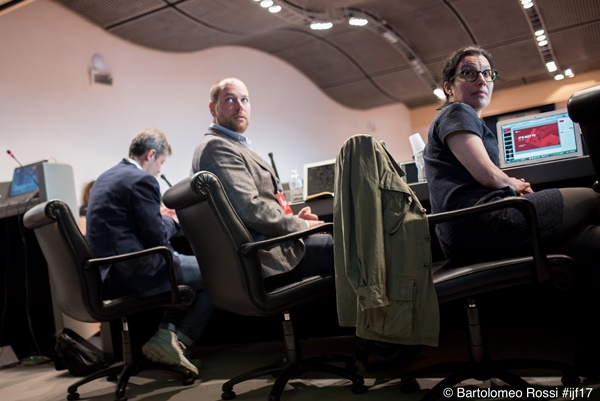
A video on US gold medal gymnast Simon Biles produced by the New York Times, which is definitely not a broadcast media, has 57 millions of views and has been shared uncountable times. This video breaks all possible TV rules in terms of audio, length and format. “So what?”, is the message by video editors working at known media such as the BBC, Deutsche Well or Business Times UK, who spoke on 6th April at the International Journalism Festival about best practices in using and producing social videos.
Esra Dogramaci worked at BBC and Al Jazeera and is now Senior Digital Editor at Deutsche Welle. And for her, there are only a few tips to keep in mind when preparing social videos. Dogramaci insists on the idea of avoiding TV practices, not copying things that others are doing but to try and innovate. The best example, Dogramaci tells the audience, is how food videos became popular after the Buzzfeed started publishing on the famous Facebook page ‘Tasty’. She also recommends not to be afraid of technology or of breaking the rules, which is essential if you want to improve your video-making skills. Again and again she calls to experiment. Dogramaci insists on the need of using data and that data analytics should be embedded in the newsrooms, although this is often not the case now. And last, she answers to the big question “is it still journalism?” without doubts: for Dogramaci this is just another format but one where you certainly use journalistic skills. From her point of view, in the newsrooms there is more and more a tendency to wait for someone to tell you what you are supposed to do, but actually, if you don’t do it, some other media will do it, so, once again, you should experiment, experiment, experiment.
John Crowley is editor-in-chief at International Business Times (IBT) UK. Prior to this he worked as digital editor for the Wall Street Journal (WSJ) in Europe, the Middle East and Africa, where his job was pretty different, he says. At the WSJ Crowley used to produce videos focused on explaining the main news of the day; while now, at IBT UK he observes live Facebook videos are becoming more and more central. As an example he cites the live cover of the recent Westminster attack, where a reporter (unnamed) was able to gather live testimonies from witnesses including Members of the UK Parliament who were in the area. Crowley points at how cheap it is to do this kind of reporting, and how many people can be engaged. Mr. Crowley defends the importance of social video but also acknowledges the need to keep some TV good practices, for instance when it comes to the verification of content, which is causing a lot of troubles to the digital media. Although IBT created a dedicated video team, for Crowley it is important to try to involve the whole newsroom in the production of video content. Something which, he says, can be easily and quickly done. He predicts that in a near future, all journalists working for digital newspapers will be expected to be able to edit videos. And he hopes so.
Nathalie Malinarich works as “mobile and new formats editor” at the BBC News. Her team spent the past few months making research before developing their strategy focused on the BBC News app. They investigated whether people, when consuming videos, were ready to flip their phones (from vertical to horizontal), if and how they used audio, the timing of access, the preferred themes and how to adapt storytelling to the new format. This led them to opt for short vertical (no need for turning the screen) and subtitled videos which they would update throughout the day and include news, features, and analysis. Malinarich explains that, usually, reporters come to the newsroom with a lot of material that is fit for TV. Then, the material is scrutinized by the videos team, which turns it into three different pieces for the three different platforms: social media, app and web.
On this, Garrett Goodman, director of business development at Wochit, explains that it is easier to take videos produced for social media and use them for news app than the other way round. Probably, Goodman considers, this is because the most popular videos on social media are much more emotional and not just pure news.
Andrea Iannuzzi is editor at the digital lab of Gruppo L’Espresso. His team was set up just few months ago, while Iannuzzi had already worked on the field with an Italian local newspaper. In his experience you don’t need a lot of resources to make things possible. In his new job, he now produces not only videos but also data visualisation and interactive pages for the entire Group L’Espresso. Iannuzzi insists that one should not be afraid to try and fail.
This is probably the main lesson all speakers of the panel leave behind. They all agree on the importance of keeping on experimenting, trying, searching for ideas to innovate and find new forms of storytelling by video. How to monetise it? Well, that’s the next big question but the first thing is to try and tell the stories.